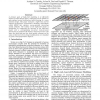272 search results - page 19 / 55 » Evaluating the Model Accuracy in Automated Design Space Expl... |
DATE
2003
IEEE
14 years 24 days ago
2003
IEEE
A primary goal of high-level modeling is to efficiently explore a broad design space, converging on an optimal or near-optimal system architecture before moving to a more detaile...
FDG
2009
ACM
14 years 2 months ago
2009
ACM
Successful lighting in video games is more than a physically accurate illumination model. Aesthetics and function are of equal or greater importance. Lighting designers may deviat...
VAMOS
2007
Springer
14 years 1 months ago
2007
Springer
Goal models have been found to be effective for representing and analyzing variability at the early requirements level, by comprehensibly representing all alternative ways by whic...
DAC
2003
ACM
14 years 8 months ago
2003
ACM
In the Artemis project [13], design space exploration of embedded systems is provided by modeling application behavior and architectural performance constraints separately. Mappin...
ICCD
2007
IEEE
14 years 4 months ago
2007
IEEE
This paper presents a methodology to generate a hierarchy of power models for power estimation of custom hardware IP blocks, enabling a trade-off between power estimation accuracy...


